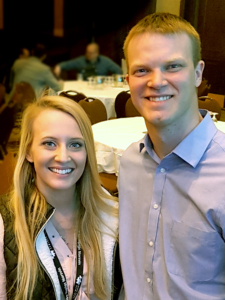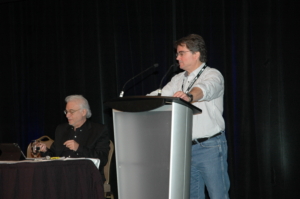Start with a base of solid science. Fold in a healthy dollop of animal-welfare and safety codes, season with a splash of hip-hop and wrap in a protective layer of media savvy to complete an effective recipe for nurturing public trust.
While interest groups battle for the hearts, minds and dollars of urban consumers, North America’s swine industry is setting an agenda of its own, aimed at the billions of people around the world for whom pork is or could be the chief source of protein.
 Speakers addressing Banff Pork Seminar in January and Alberta Pork’s Annual General Meeting late in November described how Western Canadian farms produce a healthy and safe meat product with increased efficiency and a reduced environmental impact. Others addressed the need and means for getting that message out while interest groups promote the opposite message, decrying pork as unhealthy and damaging to the environment and stoke fears about the treatment of farm animals.
Speakers addressing Banff Pork Seminar in January and Alberta Pork’s Annual General Meeting late in November described how Western Canadian farms produce a healthy and safe meat product with increased efficiency and a reduced environmental impact. Others addressed the need and means for getting that message out while interest groups promote the opposite message, decrying pork as unhealthy and damaging to the environment and stoke fears about the treatment of farm animals.
In his report to producers, Alberta Pork Chair Frank Novak said the days are gone when people generally trusted the industry without seeking proof that it was meeting high standards of environmental protection, animal care and safety of workers and the food supply and the use of anti-microbials.
Although most of Western Canada’s pork production is marketed in other countries, the right to farm lies in the hands of Canadians, said Novak.
“People in Japan aren’t going to change Canadian legislation,” he said.
Therefore, the industry needs to meet or exceed public expectations and the public must be made aware of those efforts.
Misleading data have drawn a skewed picture of the impact livestock production has on the environment and the role it will play in filling an increased demand for protein as the world population approaches nine billion, said University of California-Davis professor Frank Mitloehner, an air quality extension specialist in the Department of Animal Science.
A plenary speaker at the 2017 Banff Pork Seminar, Mitloehner was invited to offer further insight during the Alberta Pork AGM. The reality for people  pushing to end animal agriculture is that livestock play an essential role in making usable protein from marginal lands and in providing a reliable source of nutrients for crops, Mitloehner told delegates.
pushing to end animal agriculture is that livestock play an essential role in making usable protein from marginal lands and in providing a reliable source of nutrients for crops, Mitloehner told delegates.
“The only fertilizers that can be put on organic crops are organic fertilizers. Guess where they come from?”
In addition, the carbon footprint per tonne of swine and poultry production in the United States and Canada continues to shrink as genetics improve and farmers become more efficient.
“When production goes up, emissions go down. We have to learn to explain that to people in a way that they understand,” he said.
Environmental issues associated with livestock production exist in countries like India and China, where farming practices are considerably less efficient, said Mitloehner. Those are the areas where farming practices must change to meet the growing demand for animal protein that has resulted from improved economies, he said.
Reducing the amount of food wasted is key to limiting the environmental impact of farming, while there are four areas where inefficient producers can improve to meet targets: Improve animal reproduction, improve vaccination and animal health care, improve genetics and feed more energy in the diets.
“If you can do these four things, you can decrease the number of animals needed in your country to satisfy the nutritional needs,” he said.
While producers in developing countries need to update their methods, their counterparts in North America “have nothing to hide” and should take every opportunity to display their accomplishments in animal production, said Mitloehner.
Building transparency within Canada’s pork industry is vital in the push for public trust, said Crystal Mackay President of the Centre for Food Integrity, in her address to the same group of delegates.
“This concept of trust and transparency is vague – having a conversation with Canadians about what’s on their plate is a big challenge,” said Mackay. “I’m going to try to give you some tips because the framework is vague, but the action needs to start with you, one person at a time.”
Recent research compiled by the CFI found about 60 different elements to be of concern to Canadians. Topping the list was the affordability of healthy food. Mackay said Canadian pork producers are in the business of producing healthy, affordable food and they should therefore take pride in what they have achieved.
Other concerns that need to be addressed include the use of antibiotics, hormones and pesticides while only 36 per cent of Canadians believe that undercover do not represent general farming practices.
“We need to step up and show them that that’s not right,” said Mackay.
Undercover videos are the likely culprit in research indicating that American consumers do not trust farmers and instead hold food companies fully responsible for transparency on topics including food safety and animal welfare, she said.
“To me, that’s a clear indication that consumers have lost trust in farmers in the U.S., and 200 undercover videos later, can you blame them?” It’s a different story in Canada, she said.
“I think this is a really good news story, in that Canadians hold (farmers) responsible for animal welfare and environment. I think that’s the way it should be.”
However, those same people will not take a farmer’s word at face value. They want to see videos and third-party assessments as proof that farming practices are meeting expectations, said Mackay.
The most effective way to connect with the public is not by providing facts, but through shared values, she said.
“Connect with people first, and then they’ll give you permission to share their story,” she said. At Banff Pork a few weeks later, a young farmer from Kansas wowed the crowd with a project he and his siblings developed specifically to connect with their non-farming friends.
20-somethings Greg Peterson, his brothers, Nathan and Kendall and their sister, Laura are now reaping the benefits from a series of YouTube videos that arose from a simple idea he cooked up while attending university.
Their first video, “I’m A Farmer and I Grow It,” was created in the summer of 2012 as a parody of a pop tune, “I’m Too Sexy and I know it.”
The idea started while Peterson was attending university, taking a minor in music performance. He wondered why there weren’t more music videos specifically about farming.
 “Music has such a unique power to make people pay attention to something and to connect to something,” he said.
“Music has such a unique power to make people pay attention to something and to connect to something,” he said.
Peterson chose to parody “I’m too Sexy” because that was the song playing in the background one night when he was in a restaurant with a friend, pondering the idea of creating a video.
“I don’t even like that song, but I was changing the words to be about farming and my friend thought it was funny.”
He took the idea home to Nathan and Kendall. They were skeptical at first, but went to work creating a video, which they posted to YouTube on June 25, 2012.
They hoped to get 50,000 views over a couple of years.
By next morning, the video was already going viral and a local newspaper reporter was at the door, looking for an interview. On June 27, TV news crews from across the state landed in the yard and there were more reporters asking for interviews.
“By the next day, we had half a million views and we’d gotten called by National Fox News out of New York City, and they’d requested that all three brothers (Laura was not yet involved) fly to New York to be on live TV the next morning.
“My brothers and I quickly realized that we were not in Kansas anymore. You can totally see the deer-in-the-headlights look on our faces,” he said.
The brothers decided to create another video, “Family Style,” which was viewed two million times in its first two weeks on YouTube.
Peterson and his siblings have continued to make new videos based on popular songs, including clips submitted by farmers from around the world.
“Agriculture looks totally different, everywhere you go,” he said.
Along with the videos, the Petersons have now started a blog to discuss farming practices.
“We have really expanded our social media platform, to not only entertain people, but educate them as much as possible. Not everyone agrees with what we say, but we’ve tried to do it in a way where they can at least read our opinion and they’re free to disagree, but at least they’re hearing it from a farmer,” said Peterson.
While Peterson’s presentation demonstrated the value of using social media to reach non-farmers, media specialist Jeff Ansell opened the 2018 Banff Pork Seminar with a short course on managing the message when news reporters arrive at the farm.
 “When you’re in the news, it’s not usually a good story,” said Ansell, a former TV reporter now operating a communications consulting business based in Toronto.
“When you’re in the news, it’s not usually a good story,” said Ansell, a former TV reporter now operating a communications consulting business based in Toronto.
He explained to Banff Pork delegates that mainstream news reporters operating in a world of sound bites generally work from a boilerplate loaded with controversy and including a victim, a hero, a witness, an expert and a village idiot – who can also be the villain.
Ansell added a disclaimer, stating that industry writers generally do not employ the same tactics as news reporters looking for headlines.
He enlisted Alberta producer Ben Woolley to demonstrate the methods seasoned media can use to fluster and obfuscate and to show the crowd the way around pitfalls and traps.
Woolley was put through a mock interview with a seasoned reporter and media trainer who asked loaded questions about whether pork is healthy, whether piglets feel pain from castration and whether producers feed pigs to other pigs.
Woolley’s attempts to respond to Richard Maxwell’s questions were then spun into a radio story that made him appear guilty of all the above.
Ansell then offered advice on how to manage the interview to ensure that listeners, viewers or readers are getting the right message. “When the headline is you, the messages you create, the narrative you construct, the answers you give, the comments you offer, the story you tell must truly reflect your value compass.”
By allowing the reporter to lead the questions, including convincing Woolley to repeat them, the story was twisted to fit an agenda that was set before the interview started.
“Saying ‘no’ accepts the premise of the question,” said Ansell.
The better way to avoid the “fluster strategy” would be to take a few breaths, ask the reporter to repeat or explain the questions, and then make a statement that is clear and in context. Never repeat the question, said Ansell. “Do you want to be quoted using the word torture?” he said.
He held up Michael McCain’s response to the listeria disaster at a Maple Leaf plant as a great example of the right way to handle a tragic event.
Avoiding reporters sends off alarm bells, said Ansell. When news broke that some of Maple Leaf’s customers had died from sausage meat infected with listeria, McCain went on camera as soon as humanly possible. He apologized and promised to take action, coming across as honest, empathetic, accountable and forthcoming.
“You need to show your stakeholders that you get it, and ideally that would come across as genuine,” said Ansell.
Plant pathologist Steve Savage, who operates a consulting firm based in Southern California, said agriculture’s “social licence” is threatened on several fronts: The relatively small ration of people directly involved in raising and growing food, declining public investment in research and development, lack of understanding or apprehension around science-based regulation, political influence on regulation, mistrust fuelled by marketing campaigns, brand-sensitive retail players who are unwilling to support legitimate technologies that benefit producers and a subset of aggressive players – typically organic-based – who pit their products against those raised or grown by other means.
He went on to state that the agricultural community must overcome a wide range of barriers to overcome those threats, including the influence of disinformation spread by various interest groups.
Savage described an effect he terms “Dark Ages 2.0,” in the amount of knowledge available on the Internet is so overwhelming that it becomes a major challenge for the ordinary person. “What does that lead to? Increased fear and superstition.”
In a bizarre twist, well-intentioned efforts to improve public health have demonized certain food ingredients, such as saturated fat and cholesterol, to the extent that products are now being sold for what they are not rather than for what they are.
“In the vast majority of cases, those have actually turned out to be wrong, particularly some of the critiques about fat. In fact, taking fat out of the diet is probably one of the worst things we could have done, because that’s how you feel like you’re full.”
A huge abundance of disinformation, fake science and fake transparency are additional barriers facing the agriculture community.
“This is all about getting attention, getting funding, whatnot, and publishing in junk journals and things like that. So, it really messes up the situation in terms of trying to straighten out some of the problems.”
Savage also described a silo effect, in which different sectors of the agriculture community act autonomously, when they could benefit from working together.
He offered a variety of ways to address challenges in earning public trust, citing the Peterson Brothers’ use of social media as an excellent vehicle for humanizing the industry in the face of activists who find it very easy to paint a negative picture of farming.
“There is a huge need for people to see what farming is like,” said Savage. •
— By Brenda Kossowan




